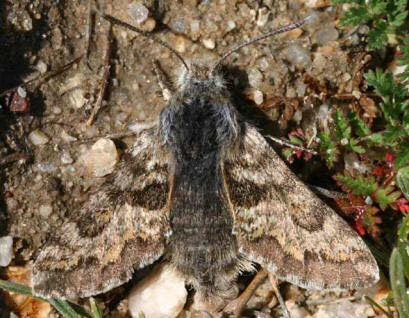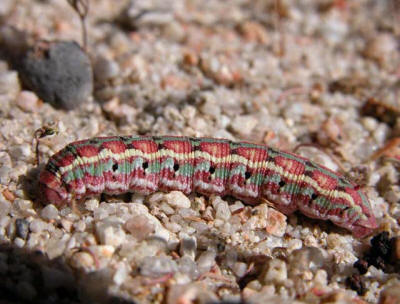Euproserpinus euterpe
- Threatened – Endangered Species Act (1980)
One of three species of sphinx moths, the Kern primrose sphinx moth occurs on the Carrizo Plain National Monument in San Luis Obispo County, in the Cuyama Valley of Santa Barbara and Ventura counties, and the Walker Basin of Kern County. It was originally thought to only occur in Kern County (hence the name), but new populations were recently discovered in Santa Barbara and Ventura counties. Two populations are now known to exist on the Los Padres National Forest, near Ventucopa in the Cuyama Valley.
The Kern primrose sphinx moth is a day-flying, moderate sized moth with a wingspan of 1-3 inches. Its hindwings have a distinct white band, and the top surface of its antenna have white scaling. The colorful larvae are hairless, but they do have a horn or spur. Interestingly, pupae are known to delay metamorphosis into adult form and stay underground for multiple years during drought periods. The moth larvae require a specific host plant for early nutritional needs, certain primrose and sun cup species, and it was believed they would starve and die if their eggs were laid on a non-host plant. However, new research has found that the larva are actually capable of short forays in search of their host plants.
The moth is usually found along sandy washes, in which the sand has the proper compaction and moisture content for burrowing larvae. The washes at the Carrizo Plain where the Kern primrose sphinx moth was observed flow north from the Caliente Range and along the Elkhorn Scarp, whereas the washes in the Cuyama Valley with confirmed sightings flow west from the Los Padres National Forest into the Cuyama River by Ventucopa and north into the Cuyama River near the town of New Cuyama.
Threats
The Kern primrose sphinx moth was listed as threatened under the federal Endangered Species Act in April 1980. In fact, the species was believed to be extinct until it was rediscovered in 1974, when a surviving population was found in Kern County. Sphinx moths are valuable to insect collectors, who have historically posed a threat to these small populations. Female Kern primrose sphinx moths fly slower and are easier to capture, which may have led to a serious depletion in females at Walker Basin.
Today a more serious and common threat is habitat destruction and degradation. The moth’s specific host plant requirements make the species particularly vulnerable to habitat degradation that results in the loss of their primary food plant, the sun cup or evening primrose (Camissonia contorta). Such habitat degradation can be caused by cattle and sheep grazing, pesticides and herbicides, off-road vehicle trespass, road maintenance, and development, as well as the expansion of the non-native, invasive, low-growing weedy plant, filaree. Filaree is an excellent nectar source for adult moths, and adult females will often lay their eggs on this plant. However, the larva cannot eat the plant and die unless they are able to relocate to their appropriate host plant nearby.
In addition, in 2005 the U.S. Forest Service approved a plan to expand oil drilling on 52,075 acres of the Los Padres National Forest. One of these drilling areas was located in Kern primrose sphinx moth habitat in the Cuyama badlands.
Conservation Efforts
The areas that offer some protection for the moth include the two populations at the Carrizo Plain on Bureau of Land Management land and two populations at the Cuyama Valley on U.S. Forest Service land. This would constitute about one-third of the entire known Kern primrose sphinx moth population. The populations on public lands are afforded some protection, including fencing installed around known populations and monitoring and population surveys when the flight season for the moth starts. All the involved federal agencies (U.S. Fish and Wildlife Service, U.S. Forest Service, and the Bureau of Land Management) also meet annually to coordinate efforts to protect the moth. However, the adequacy of these measures are unknown, and many of these populations remain vulnerable to habitat destruction.
As a federally-protected species, the Kern primrose sphinx moth is also protected by the Lacey Act, making it unlawful to import, export, sell or receive, or transport any moths whether alive or dead, including parts, products, eggs, or offspring.
In 1984, the U.S. Fish and Wildlife Service approved a recovery plan for the species, but a new recovery plan needs to be completed to incorporate important new findings including the expanded population distribution (beyond Kern County in the Carrizo Plain and Cuyama Valley) and the capability of larvae to traverse small distances to find proper host plants. ForestWatch will continue to monitor each federal agency’s work surrounding the protection of the Kern primrose sphinx moth, and will work to see that this rare moth continues to call central California home.
One of the primary ways ForestWatch has worked to protect the Kern primrose sphinx moth was through efforts to halt the expansion of oil drilling across over 52,000 acres of the Los Padres National Forest. After a drilling plan was approved by the U.S. Forest Service in 2005, ForestWatch and its partners at Center for Biological Diversity and Defenders of Wildlife filed a lawsuit challenging the plan in 2007. The agency agreed to conduct a more detailed analysis of the environmental impacts of the plan, but the conservation groups once again prepared to file a lawsuit in 2016 due to the analysis’ reliance on outdated information and data. In 2016, the U.S. Forest Service indefinitely halted the plan due to pressure from ForestWatch, a critical move which has protected important sphinx moth habitat. ForestWatch will continue to fight oil drilling and fracking expansion and other detrimental activities that could damage the Kern primrose sphinx moth’s habitat.








